‘Strange Clay’ review: a mucky, uncanny, visceral survey of ceramic art
At London’s Hayward Gallery until 8 January 2023, group show ‘Strange Clay: Ceramics in Contemporary Art’ sees ceramic artists explore the physical, psychological, political and power of their medium
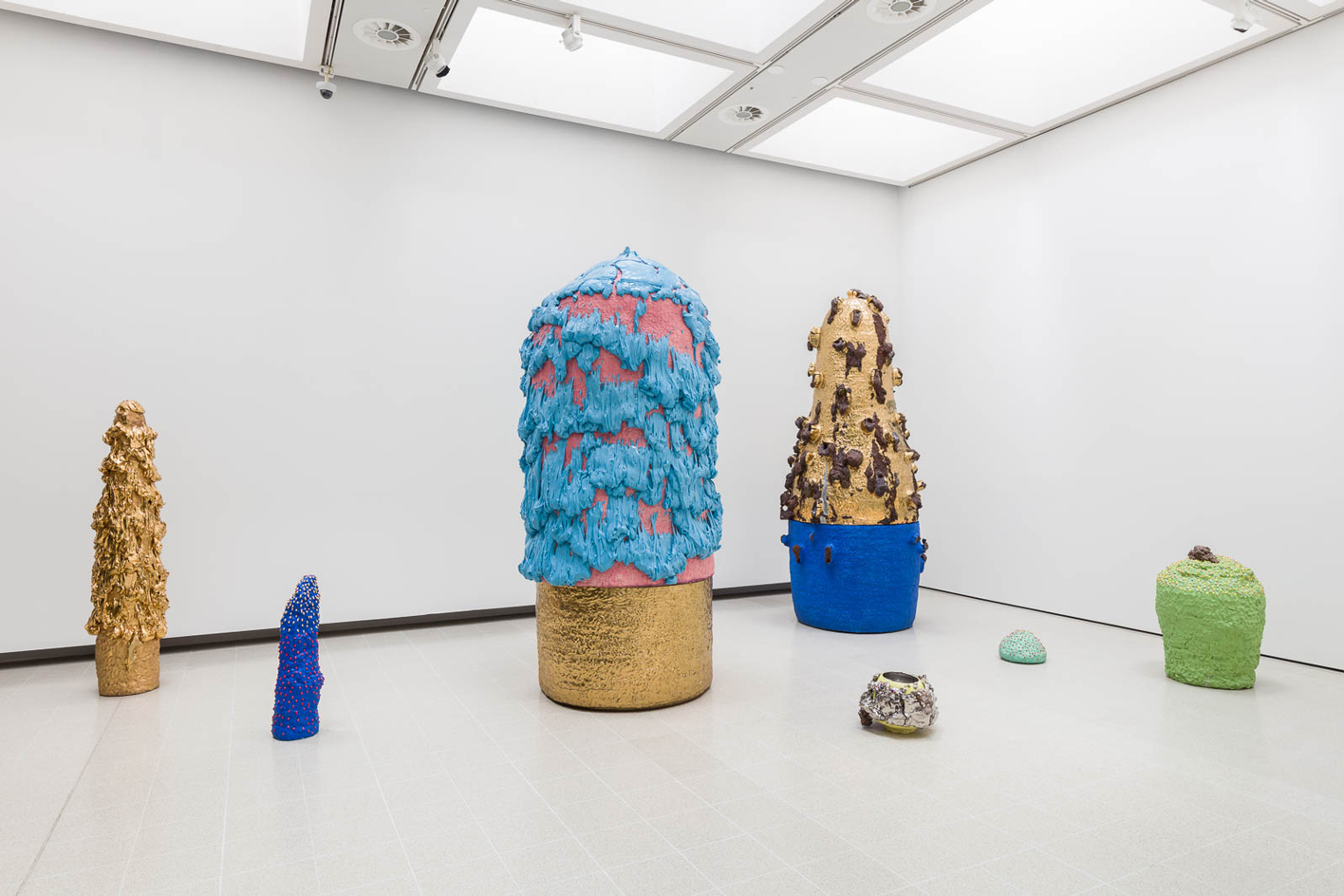
The idea of clay as a serious art form is nothing new. The traditional ‘craft’ connotations of the medium have been slipping since the second half of the 20th century, with clay becoming the material of choice for heavyweights such as Grayson Perry and Betty Woodman. More recently, artists including Lindsey Mendick, Leilah Babirye and Woody De Othello have used it for its raw, political and psychic potential.
These artists are included in Hayward Gallery’s wide-ranging new exhibition ‘Strange Clay’, which presents ceramics as fantastical and uncanny. It also manages to show quite how electrifying this medium can be. The work is vast, totemic, loud and messy. All 23 artists in ‘Strange Clay’ more than hold their own within Hayward’s cavernous brutalist architecture.

Installation view of Jonathan Baldock and Rachel Kneebone in 'Strange Clay: Ceramics in Contemporary Art’ at the Hayward Gallery

Installation view of Leilah Babirye in 'Strange Clay: Ceramics in Contemporary Art' at the Hayward Gallery
‘The good thing here is that you can put together a really serious installation,’ curator Cliff Lauson tells me. ‘There is domestically scaled work in the show, but you can also really let rip. We wanted to turn the old image of clay on its head and make it really exciting.’ He has been considering the exhibition for the last four years, engaging in long-running conversations with many of the featured artists, whose profiles have continued to soar since its inception.
‘The idea of clay as a serious art form has been bubbling at the forefront of contemporary practice for a while, alongside a wider consideration of craft,’ says Lauson. ‘The journey for many of these artists has come from looking at history through a contemporary lens. Of course, ceramics has a rich history in every country around the world.’
Jonathan Baldock’s imposing Facecrime greets visitors first entering the show. Precarious towers of ceramic cylinders emblazoned with ears, faces and mug-like handles are interrupted by floppy, unmissably phallic, balloon-like forms poking from the sides. The work captures the playfulness of the medium that threads through Strange Clay, often revealing uneasy emotional undercurrents.
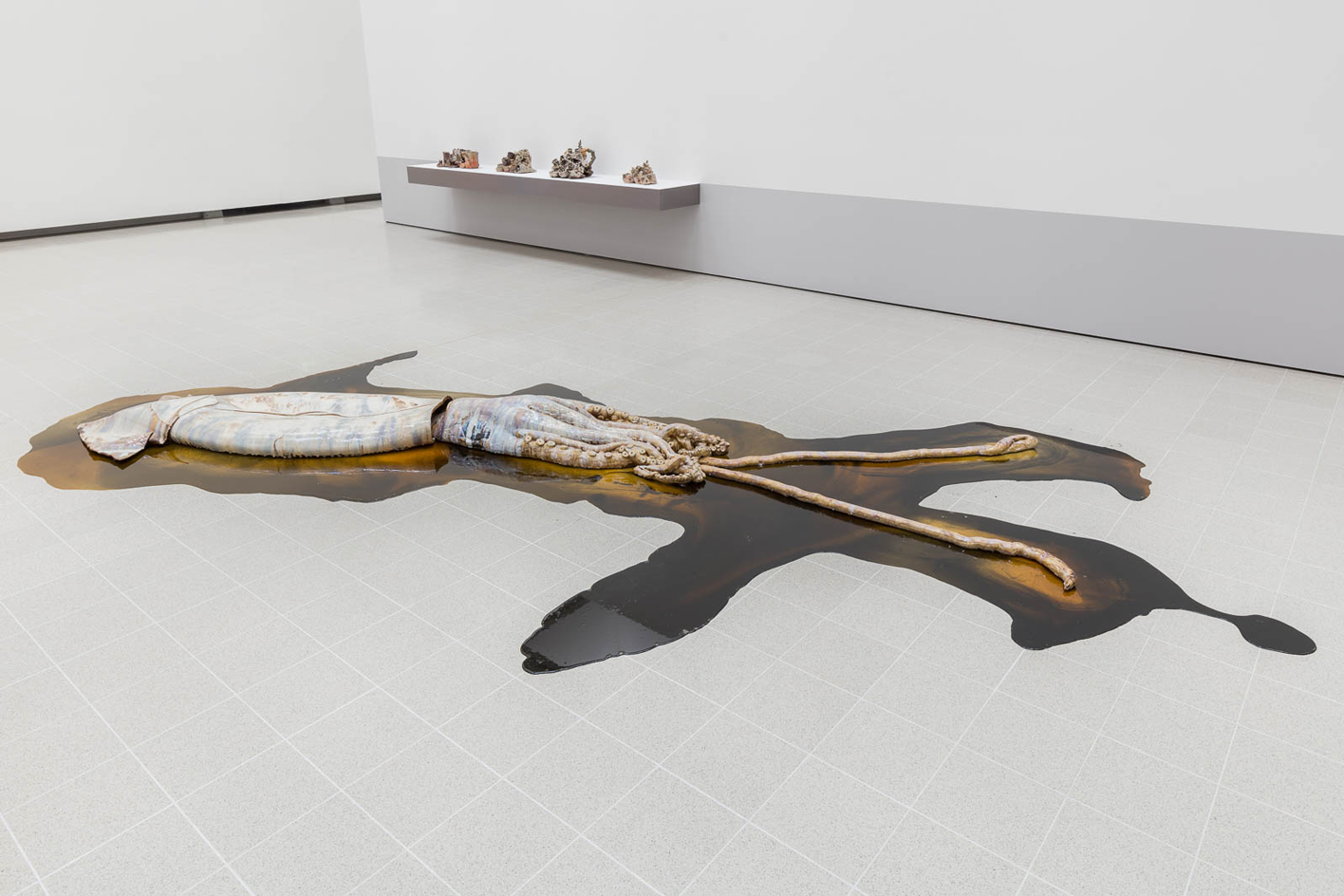
Installation view of David Zink Yi and Aaron Angell in 'Strange Clay: Ceramics in Contemporary Art' at the Hayward Gallery
Eruptions of all kinds also happen throughout the show. David Zink Yi’s giant squid is surrounded by a thick marbled slick of ink; Beate Kuhn’s collection of chalky black ceramics appears ready to burst with glowing goo; Salvatore Arancio’s volcanic forms feature iridescent columns shooting from their bases. Mess, both physical and psychological, can be found everywhere.
Lindsey Mendick brings this untidiness to a thundering climax in Till Death Do Us Part. Taking its title from Madonna’s homage to her famously troubled marriage with Sean Penn (which soundtracks the work), the installation displays the full intensity of domestic life spent with another person. Slugs writhe on the kitchen floor with their guts spilling out; rats clamber over a broken table, surrounded by blood-like splashes of red wine; cockroaches crawl over a worn-out copy of Men Are From Mars, Women Are From Venus. Mendick has poured her own experiences into this piece, creating a complex image of love and the potent battle of wills that often accompanies it.
Receive our daily digest of inspiration, escapism and design stories from around the world direct to your inbox.

Installation view of Lindsey Mendick in ‘Strange Clay: Ceramics in Contemporary Art’ at the Hayward Gallery
‘It is an emotive medium and I think we relate to it,’ Lauson tells me. ‘Tactility is there in all of the works. It’s really explicit in some. There is this trace of interaction. There is that element of the human and the earth. You can revel in the untidiness of the medium, which is often brought into the final form. It’s also bolstered by the things you can do with surface.’
Leilah Babirye creates similarly powerful work, stretching the material potential of ceramics by combining clay with found objects. In busts ranging from human-sized to 3m tall, she utilises woven old bike tyres for hair and bike chains combined with rusty lights to form a crown. Her use of discarded materials refers to abasiyazi, a Ugandan slur for queer and trans people derived from the inedible part of sugar cane that is thrown out. Babirye symbolically elevates her materials, ‘representing the queer community, my community, in a royal way’.
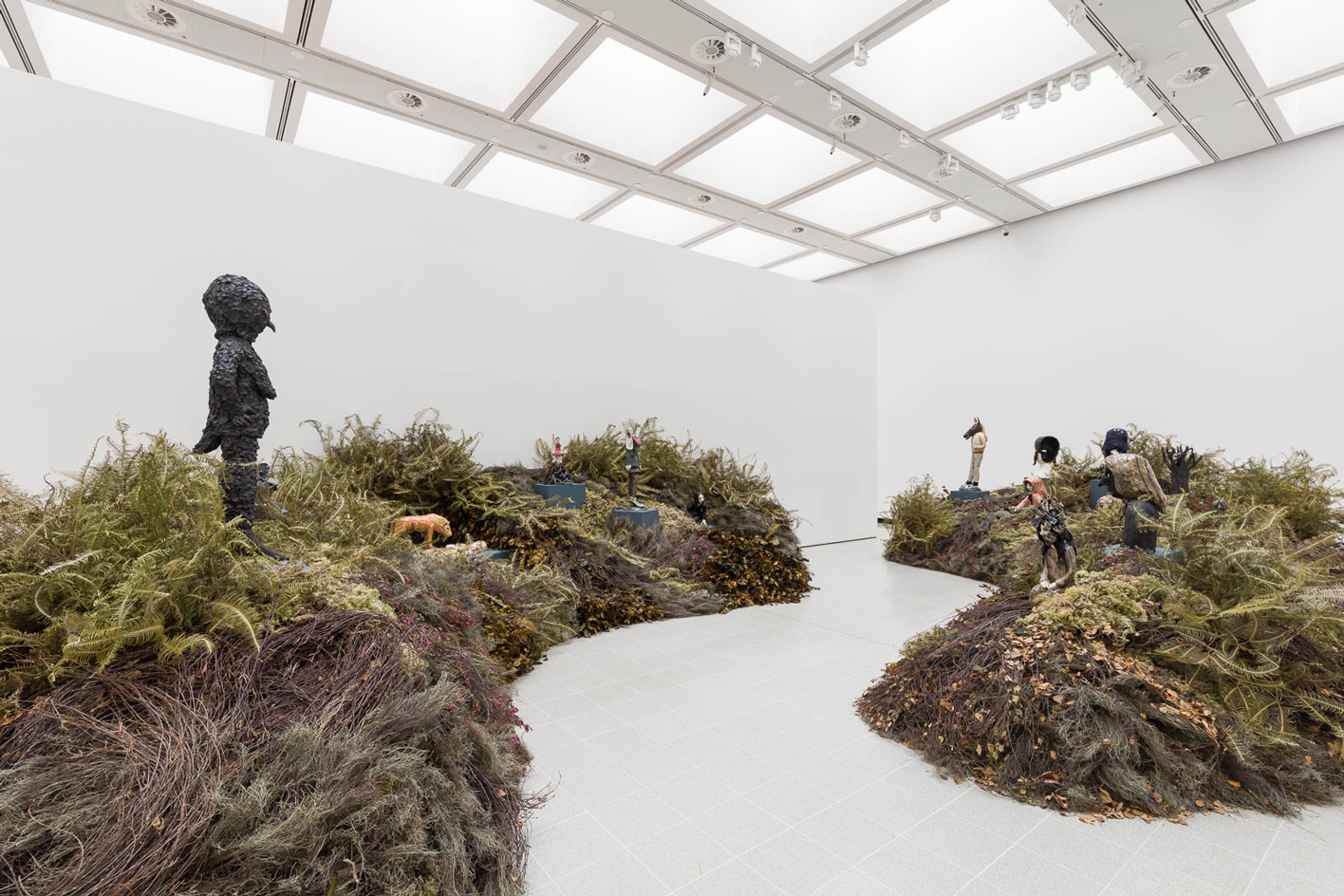
Installation view of Klara Kristalova in ‘Strange Clay: Ceramics in Contemporary Art’ at the Hayward Gallery
This expanded way of working with clay is pushed to its limits by Klara Kristolova. Far From Here features 18 stoneware figures surrounded by dried vegetation, forming a hilly landscape that viewers can walk through. The scent of dried leaves, not dissimilar to chamomile, pervades the space, noticeable before the work is within view. Each of the figures can be seen in a state of transformation, between human, animal, insect and plant forms. She combines gloss and matt finishes on her ceramics, creating an effect more akin to watercolour painting than traditional glazing.
Hayward director Ralph Rugoff mentions that ceramics sit in the middle of painting and sculpture. But this is not the only ‘between’ space that they occupy. There is also a play between liquid and solid; humour and darkness. As displayed in ‘Strange Clay’, this medium is hard to pin down, enabling a conflicted expression of what it means to be human and all of the muck that comes with it.
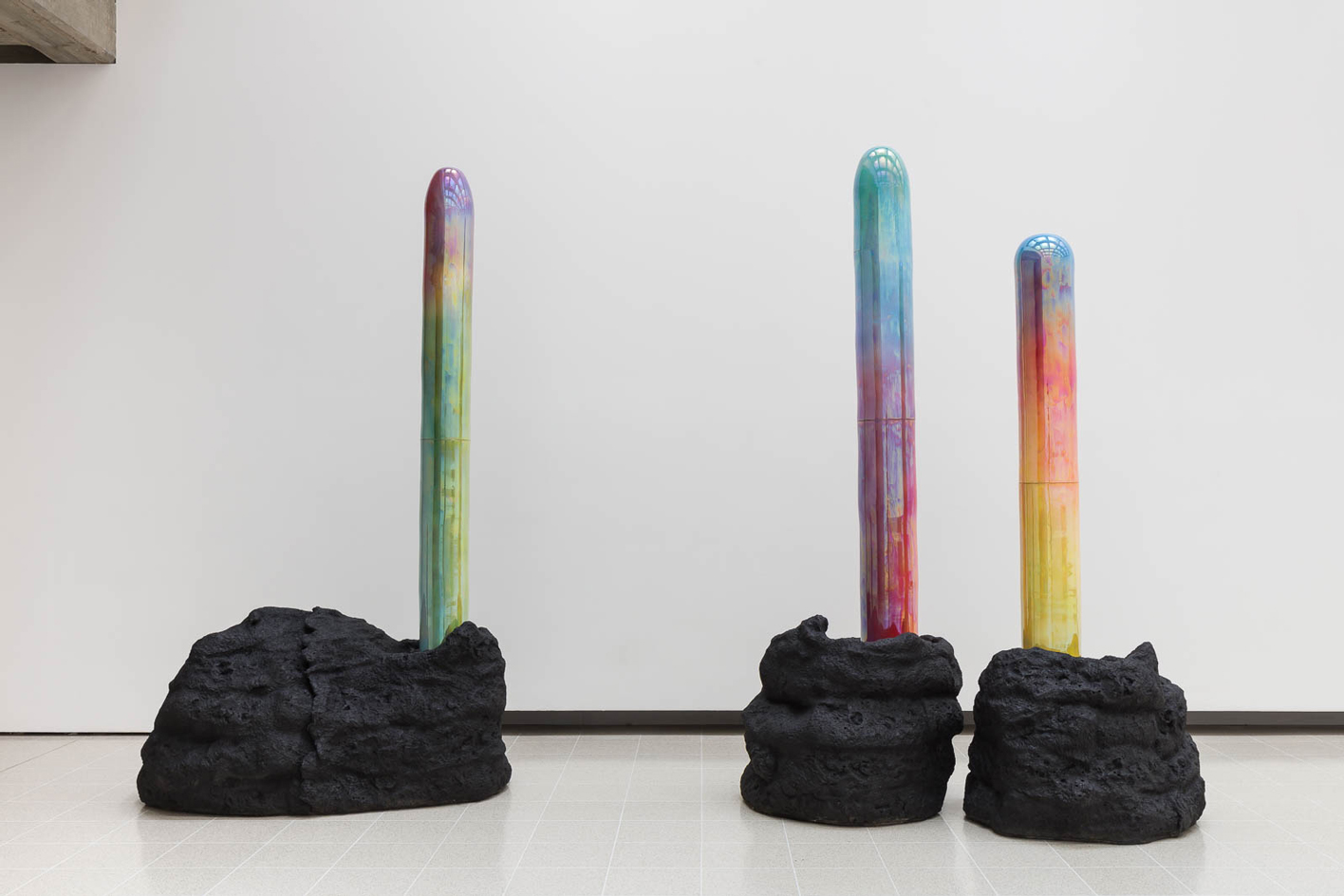
Installation view of Salvatore Arancio in ‘Strange Clay: Ceramics in Contemporary Art’ at the Hayward Gallery
Until 8 January 2023 at the Hayward Gallery, London
Emily Steer is a London-based culture journalist and former editor of Elephant. She has written for titles including AnOther, BBC Culture, the Financial Times, and Frieze.
-
 We gaze into our crystal ball to predict the tech hits (and misses) of 2026
We gaze into our crystal ball to predict the tech hits (and misses) of 2026The shape of things to come: seven technologies that will define the year ahead, from robotics, AI, aviation and more
-
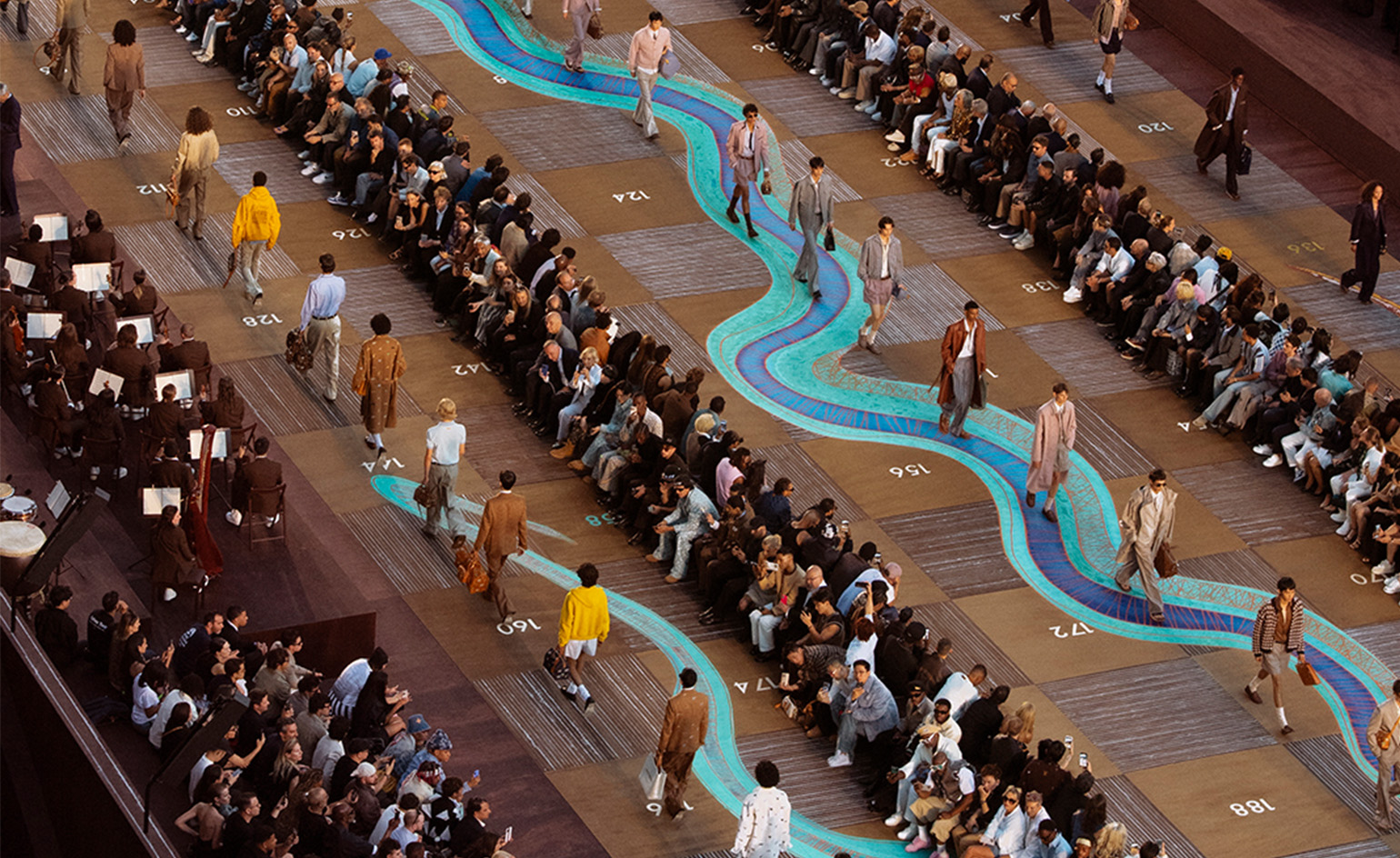 This documentary tells the story behind Louis Vuitton’s monumental Snakes and Ladders runway set
This documentary tells the story behind Louis Vuitton’s monumental Snakes and Ladders runway setThe new film offers a rare behind-the-scenes glimpse at how Pharrell Williams and Studio Mumbai conceived the 2,700 sq ft Snakes and Ladders board, which backdropped the house’s S/S 2026 menswear collection last June
-
 This remarkable retreat at the foot of the Catskill Mountains was inspired by the silhouettes of oak leaves
This remarkable retreat at the foot of the Catskill Mountains was inspired by the silhouettes of oak leavesA New York City couple turned to Desai Chia Architecture to design them a thoughtful weekend home. What they didn't know is that they'd be starting a farm, too
-
 Wallpaper* Design Awards: meet Klára Hosnedlová, art’s Best Dreamscaper
Wallpaper* Design Awards: meet Klára Hosnedlová, art’s Best DreamscaperThe immersive worlds that the Czech artist creates make her a worthy Wallpaper* Design Award 2026 winner; she speaks to us ahead of her first show at White Cube, London
-
 Out of office: The Wallpaper* editors’ picks of the week
Out of office: The Wallpaper* editors’ picks of the week'Tis the season for eating and drinking, and the Wallpaper* team embraced it wholeheartedly this week. Elsewhere: the best spot in Milan for clothing repairs and outdoor swimming in December
-
 Sculptor Woody Othello paints a Miami museum red for a show that ‘almost hugs you’
Sculptor Woody Othello paints a Miami museum red for a show that ‘almost hugs you’The Miami-born, California-based artist opens his first museum exhibition in his hometown as an experiential journey through life and lifeless objects
-
 Out of office: The Wallpaper* editors’ picks of the week
Out of office: The Wallpaper* editors’ picks of the weekFar from slowing down for the festive season, the Wallpaper* team is in full swing, hopping from events to openings this week. Sometimes work can feel like play – and we also had time for some festive cocktails and cinematic releases
-
 The Barbican is undergoing a huge revamp. Here’s what we know
The Barbican is undergoing a huge revamp. Here’s what we knowThe Barbican Centre is set to close in June 2028 for a year as part of a huge restoration plan to future-proof the brutalist Grade II-listed site
-
 Out of office: The Wallpaper* editors’ picks of the week
Out of office: The Wallpaper* editors’ picks of the weekIt’s wet, windy and wintry and, this week, the Wallpaper* team craved moments of escape. We found it in memories of the Mediterranean, flavours of Mexico, and immersions in the worlds of music and art
-
 Each mundane object tells a story at Pace’s tribute to the everyday
Each mundane object tells a story at Pace’s tribute to the everydayIn a group exhibition, ‘Monument to the Unimportant’, artists give the seemingly insignificant – from discarded clothes to weeds in cracks – a longer look
-
 Out of office: The Wallpaper* editors’ picks of the week
Out of office: The Wallpaper* editors’ picks of the weekThis week, the Wallpaper* team had its finger on the pulse of architecture, interiors and fashion – while also scooping the latest on the Radiohead reunion and London’s buzziest pizza